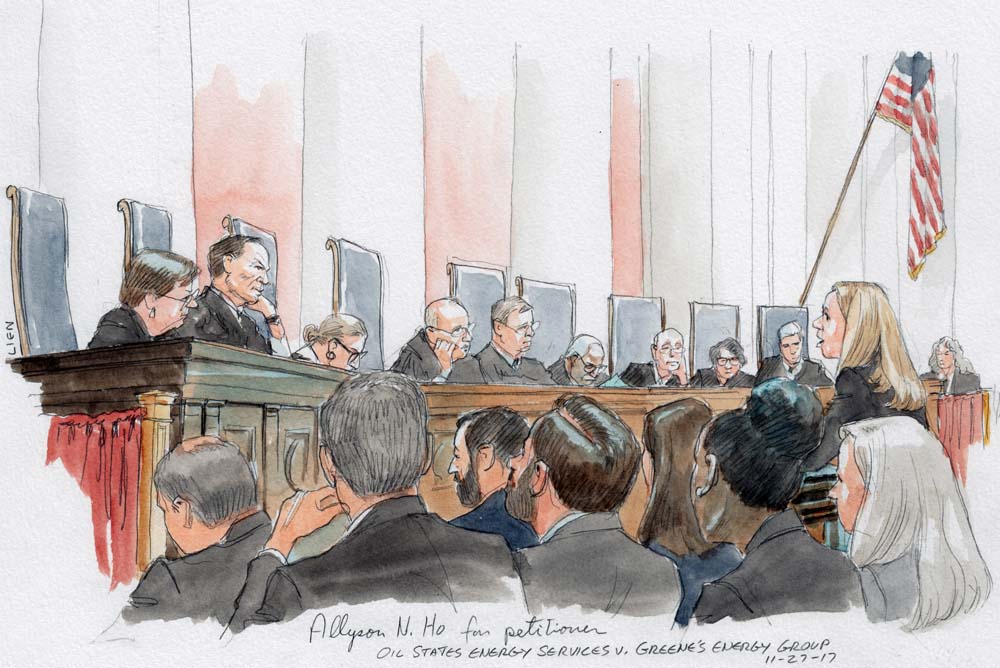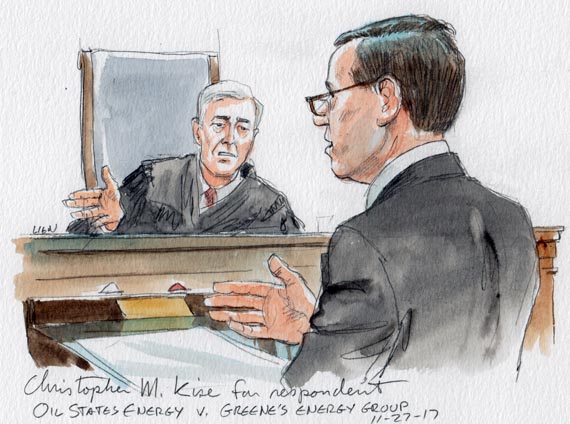Argument analysis: Justices hesitant to invalidate congressional scheme for re-examination of patents by Patent and Trademark Office (Corrected)

on Nov 28, 2017 at 12:48 pm

The justices opened their December argument sitting with a pair of patent cases, both raising questions about the inter partes review process that Congress adopted in 2011 as part of the Leahy-Smith America Invents Act. First up was Oil States Energy Services v. Greene’s Energy Group, a high-stakes dispute that directly challenges Congress’ constitutional authority. As I explained in more detail in my preview, petitioner Oil States contends that Congress violated Article III of the Constitution and the Seventh Amendment when it authorized the Patent and Trademark Office, acting at the behest of respondent Greene’s Energy, to invalidate an Oil States patent without affording Oil States an opportunity for a jury trial supervised by a federal judge.

Allyson N. Ho at lectern for petitioner (Art Lien)
As you would expect for a case raising constitutional questions that go directly to the institutional role of the judiciary, the justices came to the bench in a voluble mood. A spirited and wide-ranging argument suggested a considerable variety of perspectives, though in the end none of the justices seemed to have a strong interest in invalidating the new process.
One tack was to press the practical idea that (as Justice Ruth Bader Ginsburg put it) “there must be some means by which the Patent Office can correct the errors that it’s made, like missing prior art that would be preclusive.” When Allyson Ho (arguing on behalf of Oil States) agreed that the PTO can correct errors, Ginsburg and Justice Elena Kagan pressed her hard on why this particular error-correction mechanism is unconstitutional. Conceding that several earlier processes for error correction had been constitutional, Ho contended that inter partes re-examination is different because it effectively pits the patentholder against the alleged infringer rather than the government. Kagan in particular challenged Ho to define a clear line that would justify invalidation of this procedure but not the various error-correction mechanisms that preceded it:
Can I take you back to this question of where you would draw the line … between [the older procedures] and this? Because, as I understand what you would permit, those proceedings too can be initiated by a third party … [and] in those proceedings too, the third party can participate … can make known its views. So what’s the line? … [W]hat are the procedures that are here that you think make this essentially adjudicatory that are not in those other proceedings[?]
Ho suggested that the problem with the new procedure is that it is “trial-like,” but Kagan plainly found that inadequate: “And so what is [the defect]? Is it discovery? Is it … participation in the hearing? I just want to ground this in something.”
Justice Sonia Sotomayor joined in the discussion. Responding to Ho’s suggestion that participation by the third party is the central flaw of the new procedure, Sotomayor pointed out that under the pre-existing procedures:
You can’t write the PTO and say: I think this patent’s invalid, period. You have to supply them with a reason for doing what they’re doing. So why is that reason any different than actively participating and pointing the PTO in the right direction? What is so fundamentally Article III that changes this process into an Article III violation?
Sotomayor went on to offer another reason why she doubts the characterization of the new procedure as essentially a dispute between the third party and the patent holder: “[I]f the third party settles with the patent owner, the PTO can still continue the action, can still decide the question, can still participate on appeal. So it is a public issue that is being litigated or discussed or adjudicated, so isn’t that quite different than a normal adjudication?” Ginsburg seemed particularly taken with that point, more or less forcing Ho to acknowledge that it was “an error” for her to have said in her brief that “the PTO can’t go on … if the parties settle.”
Justice Anthony Kennedy had a somewhat different take on the problem, emphasizing the oddity of a constitutional rule that would limit Congress’ authority to specify the procedures for evaluating an asset that exists only by Congressional authority: He started by asking whether “Congress [could] say that we are reducing the life of all patents by 10 years?” When Ho didn’t dispute the point, he retorted: “[D]oesn’t that show that the patent owner has limited expectations as to the scope and the validity of the property right that he holds?”
Not surprisingly, Justice Stephen Breyer saw the case through a broader perspective on the administrative state:
I thought it’s the most common thing in the world that agencies decide all kinds of matters through adjudicatory-type procedures often involving private parties. So what’s special about this one, or do you want to say it isn’t special and all the agency proceedings are unlawful? Because a lot of them would fit the definition, I think, that you propose.
Ho tried to take the former approach, suggesting that it is rare to have administrative adjudications in which the government is not acting “as the enforcer,” but Breyer responded with examples of disputes among airlines, trucking companies and utilities, as well as between management and employees, all situations in which administrative law “judges” resolve disputes among private parties through trial-like proceedings.
A protracted historical discussion exemplified the depth of engagement. All agree that the constitutional boundaries of Congress’ authority depend on historical practice at the time of the framing. Ho pointed to a tradition of common-law adjudication of cases involving patent infringement, but Sotomayor took issue with her historical argument, citing a long-enduring practice of executive retraction of patents:
[I]s your position that somehow at the founding in 1789, given the replete English history of the crown and the Privy Council … sidestepping any judicial adjudication of validity, that in 1789 the founders intended to change that system as radically as to say, no, we’re not going to permit … the legislature to change the terms of a patent grant?
Apparently referring to an amicus brief filed by Professor Tomas Gomez-Arostegui, Sotomayor commented that even “[y]our strongest amici says that it had waned over time … But the fact that it waned didn’t mean it was eliminated, and it didn’t mean that the Privy Council or the crown thought that it no longer had those rights.”

Christopher M. Kise for respondent (Art Lien)
That is not to say that the argument went all that smoothly for Christopher Kise (arguing on behalf of the respondent, Greene’s Energy). His assertion that Congress had almost plenary authority to define the boundaries of patent grants struck a nerve with Chief Justice John Roberts, who responded:
[Y]our position, it strikes me, is simply that you’ve got to take the bitter with the sweet. If you want the sweet of having a patent, you’ve got to take the bitter that the government might reevaluate it at some subsequent point. … [H]aven’t our cases rejected that … proposition? We’ve said you … cannot put someone in that position. You cannot say, if you take public employment, we can terminate you in a way that’s inconsistent with due process.
The justices were particularly concerned about incidents in which the PTO director admittedly “stacked” the panels of particular cases in an effort to control the outcome of those cases – Roberts and Justice Neil Gorsuch both criticized that practice.
Gorsuch was by far the most critical of the inter partes review process, suggesting a view almost precisely the opposite of Breyer’s – that the Constitution might prohibit administrative adjudication altogether in any case in which the decisionmaker is not “adjunct” to an Article III court. Absent some arrangement “like a magistrate judge or a bankruptcy judge,” Gorsuch found it unsettling that there could be “a self-executing judgment issued by the director that, [even] if not appealed, has all the force of law of an Article III court.” As Gorsuch pointed out, the system doesn’t work that way “with respect to magistrate judges or anything like that. …[T]he district judge has to put its imprimatur on it before it has [full force and effect.]” To me, though, the critical comments sounded more like an effort to coalesce upon an explanation for exactly why the court should uphold the inter partes review procedure than an explanation of why it should invalidate the procedure.
Given the Supreme Court’s track record of sharply divided decisions in cases that explore the minimum requirements of Article III adjudication, it would be astonishing if the justices found a ready consensus here. My sense, though, is that there will be a strong majority to uphold the statute. The justices well might write with caution – and they might spend several months doing it – but I think it most unlikely that this case will lead the court to take as bold a step as invalidating a major congressional initiative like the inter partes review process.
This post has been corrected to reflect that an amicus brief referenced by Sotomayor was submitted by H. Tomas Gomez-Arostegui, not Alliacense Limited.
[Disclosure: Goldstein & Russell, P.C., whose attorneys contribute to this blog in various capacities, is among the counsel on an amicus brief in support of the petitioner in this case. The author of this post, however, is not affiliated with the firm.]


